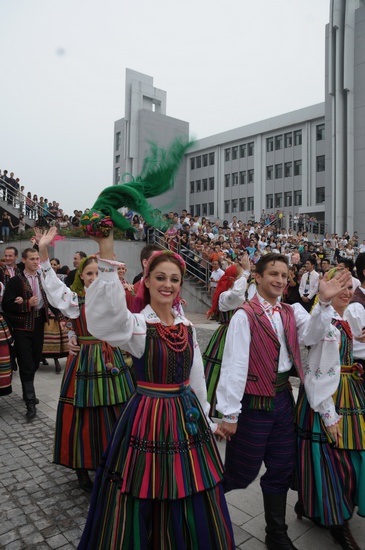
Gala of Artists from Different Countries. Photo By Yang Shutian

State Folk Song and Dance Ensemble “Mazowsze” of Poland at the campus of Hebei University of Technology. Photo By Yang Shutian
From the consideration of continents choice of art troupes, the 9th CIFAF embodied the sponsor’s idea that international folk cultural exchanges must coordinate with the official diplomacy in a perfect way. In the communications between countries, international cultural exchanges will compensate for the limitation of traditional diplomacy and media publicity. Since China became the second largest economy, great changes have taken place in the international circumstance that confronts China. In diplomacy, besides the long-term pressure of existing “Theory of China’s Threat”, China has been increasingly accused of “Neocolonialism”. In this case, while maintaining good relationship with those advanced countries, China is supposed to strengthen exchange with and better understanding of mass developing countries, which is equally important to the world peace and development. Such official communications with other countries as diplomacy and external publicity are indeed effective to some extent; however, they are not face-to-face and thus have their own limitations. The foreigners’ personal experiences created by international cultural exchange will play an indispensible role in eliminating bias and misunderstanding. We can obviously see in the 9th CIFAF that sponsor has taken all above into consideration and determined that the geographic scale of art troupes must involve the five continents, namely two from Asia (National Folk Song and Dance Ensemble of Mongolia and National Performing Arts Group of Pakistan), three from Africa (Al Tannoura Troup of Egypt, the Dance Ensemble of Ethiopian National Theater and the Ballet Silaba of Senegal), four from Europe (Folk Dance Group “Salajka” of Czech, the State Folk Song and Dance Ensemble “Mazowsze” of Poland, the National Choir Pyatnitskiy of Russia and the Ballet Julia Grecos of Spain), three from America (The Cappella Group Voz En Punto of Mexico, the National Steel Symphony Orchestra of Trinidad and Tobago and the Utah Valley University Ballroom Dance Company of USA) and one from Oceania (Fly By Wire Rock and Roll Covers Band of Australia). Among those 13 art troupes, some come from developed countries but more come from developing countries. The constitute of art troupes in the 9th CIFAF is in accordance with China’s diplomatic ideal that all the countries should be equal regardless of size or population.
In summary, there are following characteristics from the 9th CIFAF for reference in the future international folk exchange events.
First of all, the 9th CIFAF fully manifested the spirit of frugality in organization. Recently, we have discovered that some international art festival and cultural exchange events were in pure pursuit of luxury, which should be corrected immediately. In the course of international cultural exchange, the blind presentation of luxury will probably make those artists from developing countries feel antipathetic because as far as those countries are concerned, they will interpret the luxury for intentional show-off as the second-largest economy in the world, which will have negative impact on our strategy of sustainable development. The 9th CIFAF has set a good example in frugality. All the visiting art troupes presented performances mainly in the public locations such as school, university, community and square in Yichang of Hubei Province and Beijing. Instead of luxurious stage and magnificent lighting designs, this event focused on bringing pure folk arts of varied cultures to Chinese people. Within a short duration of ten days, 302 artists from the 13 art troupes of five continents presented excellent programs for local audiences. At each venue of performance, they also witnessed the simple equipment and every detail of frugality in the whole course.
Secondly, the 9th CIFAF highlighted the characters of folk exchange and service for the people. As most performances of the CIFAF took place in such public locations as university, community and square, many ordinary people were able to enjoy the outstanding performances by foreign artists free of charge. In a performance at Yuting Park of Beijing, we noticed that stands were so crowded that even the narrow corridor in the rear was fully occupied. With openness to the public free of charge, we could find foreigners, domestic citizens, grey-haired elderly, adorable kids, employees of park and peasant workers at rest, who just returned from heavy labor. Against the cool wind of autumn, the audiences at the stands as well as those standing in the rear watched the whole performance from beginning to end with great interest. Despite differences in personal background and social status, in the same space of artistic appreciation, everyone was endowed with equality, good order and happiness, which was indeed a touching scene.
Thirdly, the 9th CIFAF was good at facilitating the interaction between artists and audiences, which highly strengthened the exchange between artists of various countries and ordinary people in China. Just take Yuting Park for example, some foreign artists entered the audience stands or invited them to join their performance. When Egyptian dancers approached the audience with their rotating round skirts or Ethiopian artists danced dynamically nearby local people, the audience would put on hearty smiles in excitement. At the sight of their joyful expressions, you would realize that it was just the happiness of arts that bridge between the people of different cultures, languages and beliefs.
There is a saying in the Book of Documents that it is a must to offer kindness to people with one heart and one mind, which is also suitable for our international folk cultural exchanges. We can say that the arts that serve the people will facilitate international exchange. If we insist on frugality and the objective of serving the people, artists and the peoples of the world will highly think of our pursuit. By that time, we believe, China’s ideals such as Peaceful Development and Harmonious World will have been widely recognized and accepted in the global circumstance.
(The author is deputy director general of Institute of Public Relations and Media Research and professor of Communication University of China.)














